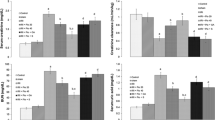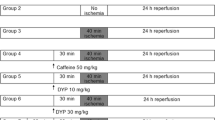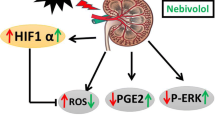Abstract
The present study was designed to investigate the role of glycine in ischemia reperfusion-induced acute kidney injury (AKI) in rats. The AKI was induced in rats by occluding renal pedicles for 40 min followed by reperfusion for 24 h. The AKI was assessed by measuring creatinine clearance, blood urea nitrogen, plasma uric acid, potassium, fractional excretion of sodium, and microproteinuria. The oxidative stress in renal tissues was assessed by quantification of myeloperoxidase activity, thiobarbituric acid-reactive substances, superoxide anion generation, and reduced glutathione level. Glycine (100, 200, and 400 mg/kg, i.p.) was administered to rats 30 min before subjecting to AKI. The glycinergic receptor blocker, strychnine (0.75 mg/kg i.p.), and glycine-binding site blocker at N-methyl-D-aspartate (NMDA) receptor, kynurenic acid (300 and 600 mg/kg i.p.), were used in the present study. The ischemia reperfusion induced AKI as witnessed by significant change in plasma, urinary, and tissue parameters employed in the present study. Glycine treatment increased ischemia reperfusion-induced AKI. The treatment with strychnine did not show any protection, whereas kynurenic acid ameliorated renal ischemia reperfusion-induced AKI. The results obtained in present study suggest that glycine increases ischemia reperfusion-induced renal damage through NMDA receptor agonism rather than strychnine-sensitive glycinergic receptors. Hence, it is concluded that glycine aggravates ischemia reperfusion-induced AKI. In addition, the activation of strychnine-insensitive glycine-binding site of NMDA receptors is responsible for its renal-damaging effect rather than strychnine-sensitive glycinergic receptors.






Similar content being viewed by others
References
Cerda J, Bagga A, Kehr V, Chakravarthi RM (2008) The contrasting characteristics of acute kidney injury in developed and developing countries. Nat Clin Pract Nephrol 4:138–153
Chen TH, Chang CH, Lin CY, Jenq CC, Chang MY, Tian YC, Hung CC, Fang JT, Yang CW, Wen MS, Lin FC, Chen YC (2012) Acute kidney injury biomarkers for patients in a coronary care unit: a prospective cohort study. PLoS ONE 7:e32328
Hsu CY, McCulloch CE, Fan D, Ordonez JD, Chertow GM, Go AS (2007) Community-based incidence of acute renal failure. Kidney Int 72:208–212
Pundir M, Arora S, Kaur T, Singh R, Singh AP (2013) Effect of modulating the allosteric sites of N-methyl-D-aspartate receptors in ischemia-reperfusion induced acute kidney injury. J Surg Res 183:668–677
Ricci Z, Ronco C (2012) New insights in acute kidney failure in the critically ill. Swiss Med Wkly. doi:10.4414/smw.2012.13
Devarajan P (2011) Biomarkers for the early detection of acute kidney injury. Curr Opin Pediatr 23:194–200
Dutertre S, Becker CM, Betz H (2012) Inhibitory glycine receptors: an update. J Biol Chem 287:40216–40223
Yang CR, Svensson KA (2008) Allosteric modulation of NMDA receptor via elevation of brain glycine and d-serine: the therapeutic potentials for schizophrenia. Pharmacol Ther 120:317–332
Gundersen RY, Vaagenes P, Breivik T, Fonnum F, Opstad PK (2005) Glycine-an important neurotransmitter and cytoprotective agent. Acta Anaesthesiol Scand 49:1108–1116
Wheeler MD, Ikejema K, Enomoto N, Stacklewitz RF, Sebera V, Zhong Z, Yin M, Schemmer P, Rose ML, Rusyn I, Bradford B, Thurman RG (1999) Glycine a new anti-inflammatory immunonutrient. Cell Mol Life Sci 56:843–856
Zhong Z, Wheeler MD, Li X, Froh M, Schemmer P, Yin M, Bunzendaul H, Bradford B, Lemasters JJ (2003) l-Glycine: a novel antiinflammatory, immunomodulatory, and cytoprotective agent. Curr Opin Clin Nutr Metab Care 6:229–240
den Eynden JV, Ali SS, Horwood N, Carmans S, Brone B, Hellings N, Steels P, Harvey RJ, Rigo JM (2009) Glycine and glycine receptor signalling in non-neuronal cells. Front Mol Neurosci 2:1–12
Yin M, Zhong Z, Connor HD, Bunzendahl H, Finn WF, Rusyn I, Li X, Raleigh JA, Mason RP, Thurman RG (2002) Protective effect of glycine on renal injury induced by ischemia-reperfusion in vivo. Am J Physiol Ren Physiol 282:F417–F423
Heyman SN, Brezis M, Epstein FH, Spokes K, Rosen S (1992) Effect of glycine and hypertrophy on renal outer medullary hypoxic injury in ischemia reflow and contrast nephropathy. Am J Kidney Dis 19:578–586
Wetzels JF, Yu L, Shanley PF, Burke TJ, Schrier RW (1993) Infusion of glycine does not attenuate in vivo ischemic acute renal failure in the rat. J Lab Clin Med 121:263–267
Kapil A, Singh JP, Kaur T, Singh B, Singh AP (2013) Involvement of peroxisome proliferator-activated receptor gamma in vitamin D-mediated protection against acute kidney injury in rats. J Surg Res 185:774–783
Petrat F, Boengler K, Schulz R, de Groot H (2012) Glycine, a simple physiological compound protecting by yet puzzling mechanism(s) against ischaemia-reperfusion injury: current knowledge. Br J Pharmacol 165:2059–2072
Yamanouchi K, Eguchi S, Kamohara Y, Yanaga K, Okudaira S, Tajima Y, Kanematsu T (2007) Glycine reduces hepatic warm ischaemia-reperfusion injury by suppressing inflammatory reactions in rats. Liver Int 27:1249–1254
Alcaraz-Contreras Y, Garza-Ocanas L, Carcano-Diaz K, Ramirez-Gomez XS (2011) Effect of glycine on lead mobilization, lead-induced oxidative stress, and hepatic toxicity in rats. J Toxicol 2011:e430539
Nissim I, Weinberg JM (1996) Glycine attenuates Fanconi syndrome induced by maleate or ifosfamide in rats. Kidney Int 49:684–695
Sogabe K, Roeser NF, Venkatachalam MA, Weinberg JM (1996) Differential cytoprotection by glycine against oxidant damage to proximal tubule cells. Kidney Int 50:845–854
Weight SC, Furness PN, Bell PR, Nicholson ML (1997) A new model of renal warm ischaemia reperfusion injury. Transplant Proc 29:3002–3003
Weight SC, Furness PN, Nicholson ML (1998) New model of renal warm ischaemia-reperfusion injury for comparative functional, morphological and pathophysiological studies. Br J Surg 85:1669–1673
Zager RA, Jurkowitz MS, Merola AJ (1985) Responses of the normal rat kidney to sequential ischemic events. Am J Physiol 249:F148–F159
de Paula HM, Hoshino K (2003) Antipanic procedures reduce the strychnine-facilitated wild running of rats. Behav Brain Res 147:157–162
Herberg LJ, Rose IC (1989) The effect of MK-801 and other antagonists of NMDA-type glutamate receptors on brain-stimulation reward. Psychopharmacology 99:87–90
Urenjak J, Obrenovitch TP, Zilkha E (1999) Effect of probenecid on depolarizations evoked by N-methyl-D-aspartate (NMDA) in the rat striatum. Naunyn Schmiedebergs Arch Pharmacol 355:36–42
Brieger K, Schiavone S, Miller FJ Jr, Krause KH (2012) Reactive oxygen species. Swiss Med Wkly. doi:10.4414/smw.2012.13659
Rhyu DY, Yang Y, Ha H, Lee GT, Song JS, Uh ST, Lee HB (2005) Role of reactive oxygen species in TGF-beta1-induced mitogen-activated protein kinase activation and epithelial-mesenchymal transition in renal tubular epithelial cells. J Am Soc Nephrol 16:667–675
Matilla B, Mauriz JL, Culebras JM, Gonzalez-Gallego J, Gonzalez P (2002) Glycine: a cell-protecting anti-oxidant nutrient. Nutr Hosp 17:2–9
Selvaraju R, Subbashinidevi K (2011) Impact of glycine on antioxidant defense system in rats with alcohol induced liver injury. Int J Res Pharm Biomed Sci 2:1314–1320
Conflict of interest
The authors do not have any conflict of interest.
Author information
Authors and Affiliations
Corresponding author
Rights and permissions
About this article
Cite this article
Arora, S., Kaur, T., Kaur, A. et al. Glycine aggravates ischemia reperfusion-induced acute kidney injury through N-Methyl-D-Aspartate receptor activation in rats. Mol Cell Biochem 393, 123–131 (2014). https://doi.org/10.1007/s11010-014-2052-0
Received:
Accepted:
Published:
Issue Date:
DOI: https://doi.org/10.1007/s11010-014-2052-0




